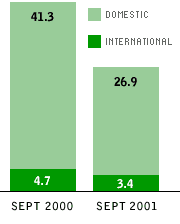|
The Airlines
Magnitude of Layoffs Hinges on Traffic Rebound
 Listen to Jackie Northam's report on All Things Considered. Listen to Jackie Northam's report on All Things Considered.
 Listen to Adam Hochberg's report on Morning Edition. Listen to Adam Hochberg's report on Morning Edition.
 More NPR News radio coverage on the airline industry. More NPR News radio coverage on the airline industry.
Oct. 22, 2001 -- One of the first signs of the economic damage caused by the Sept. 11 terrorist attacks was the spate of airline layoff announcements. With passenger traffic in September down more than one-third compared to a year earlier, the airlines made plans to let go more than 100,000 employees.
 |
|
Aviation Layoffs
• Boeing Co.: up to 30,000 by end of 2002
• AMR (American Airlines, American Eagle, TWA): 20,000
• United Airlines: 20,000
• Delta: 13,000
• Continental: 11,000
• US Airways: 11,000
• Northwest: 9,000
• America West: 2,000
• American Trans Air: 1,500
• Midway: 1,700 (shuts down)
• Spirit Airlines: 800
• Midwest Express: 450
• Frontier Airlines: 440
• Hawaiian Airlines: 430
• National Airlines: 300
• British Airways: 5,200
• Air Canada: 5,000
• Swissair: 3,000
• Virgin Atlantic: 1,200
Sources: Associated Press, NPR research, ATA
|

|
But more than a month after the cuts were announced, it's still uncertain how many pink slips have actually been handed out, NPR's Jackie Northam reports on All Things Considered.
Phillip Bagley, an airline analyst with Standard & Poor's, says many airlines are not disclosing how many jobs will be cut or when until they release their quarterly financial results several weeks from now. "Some of the airlines that are in better shape financially, such as Delta, have been able to be a bit more generous with their employees or try to rely more on retirements with cash buyouts," he says.
Delta has announced plans to lay off 13,000 workers; American Airlines cut 20,000 jobs immediately, though that number included early retirements. United hasn't specified how it will reach its proposed 20,000 job cuts.
But other airlines have modified their initial estimates. "Continental originally announced 12,000 layoffs. That's since been reduced to 11,000," says Mike Wascom, a spokesman for the Air Transport Association (ATA). "Similarly, Northwest originally announced 10,000. That's now down to 9,000."
Steve Lott, business editor for Aviation Daily says some airlines may be moving slower on the job-cutting front to see whether business rebounds. "The hope is that airlines will not have to cut as many jobs as previously announced and they'll be able to slow the growth of these cuts or even bring some people back," Lott says.
Despite a $15-billion federal bailout, "this will be a slow recovery," says Carl Hallett, president and chief executive officer of the ATA. Load factors -- the percentage of airline seats filled -- dropped to 59% in September, down from about 70% a year earlier. And while those percentages "are inching upward," they are based on significant reduction in flights, Hallett says. Many of the major airlines cut their schedules by at least 20 percent after Sept. 11 because of the public's fear of flying.
 | |
Total number of passengers boarding U.S. aircraft (in millions).
Source: Air Transport Association
Graphic: Erik Dunham, NPR
|
United Airlines' parent, UAL Corp., warned last week that it would go out of business next year if it did not reverse the drop in passenger traffic. "Never in our 75-year history have we faced an economic challenge of this magnitude, where the drop-off in air travel has been so unexpected and prolonged," Chairman and CEO James E. Goodwin said in a letter to employees.
Noting that United's financial problems did not start Sept. 11, Goodwin said, "In the past, we struggled to make a profit. Now we're in a struggle just to survive ... Today, we are literally hemorrhaging money. Clearly, this bleeding has to be stopped -- and soon -- or United will perish sometime next year."
But United's labor unions say Goodwin's doomsday predictions were an attempt to pressure employees to accept lower wages.
"United Airlines will continue to fly tomorrow, next month and next year," says Tom Buffenbarger, president of the International Association of Machinists and Aerospace Workers.
Indeed, United recently joined Southwest Airlines in resuming national advertising for the first time since the attacks, NPR's Adam Hochberg reports on Morning Edition. The airlines, while asking the public to return to flying, must be careful not to come across as desperate for business or insensitive to the events of Sept. 11, experts say.
NPR Coverage
• Read about the debate over whether airport passenger screeners should be federal employees, Oct. 5, 2001.
• Read about the reopening of Reagan Washington National Airport, Oct. 2, 2001.
• Read how federal officials made plans to allow flights to resume, Sept. 12, 2001.
Other Resources
• Air Transport Association
• Federal Aviation Administration
• Department of Transportation
• UAL Chairman and CEO James E. Goodwin's Oct. 18, 2001, letter to United employees
• International Association of Machinists and Aerospace Workers
|